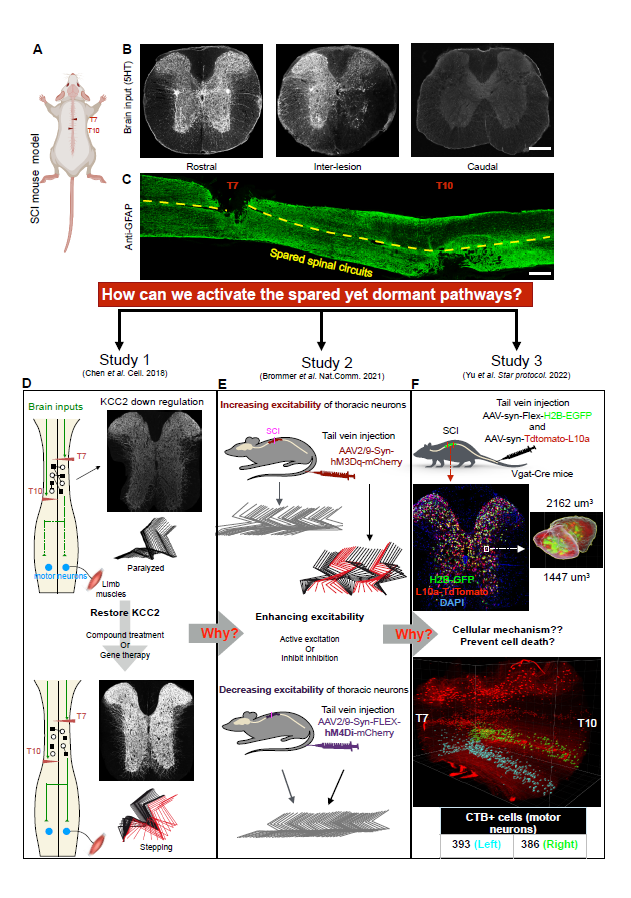Bo Chen, PhDAssistant Professor
 Department of Neurobiology
Department of Neurobiology
Room 4.212D Research Building 17
Route: 0620 | Tel: (409) 747-2214 | bochen1@utmb.edu
Education and Training
Postdoctoral training, Boston Children’s Hospital, Harvard Medical School, Boston, U.S.
Research interests: Searching for new strategies to promote functional recovery after spinal cord injury
Spinal cord injury (SCI) has an immediate and devastating impact on the control of movement and many essential physiological functions. Over the past century, progress in the understanding of injury mechanisms has transformed the clinical management of SCI. Despite profound development in the field, a randomized clinical trial has yet to demonstrate the efficacy of a repair strategy to improve functional recovery after SCI. Therefore, there is pressing demand for exploring new strategies to treat SCI patients.
In the past decades, researchers focused on limited spontaneous regeneration of the central nervous system after injury, therefore, pre-clinical research into therapies for SCI mainly targets two aspects: 1). Enhancing long-projecting descending brain inputs to restore the source of spinal circuit modulation and excitation; 2). Preventing the development of tissue pathology around lesion sites to promote penetration of spared axons. In recent years, advanced imaging and viral-based tracing techniques revealed that most SCI are anatomically incomplete, allowing spared brain descending axons and surviving spinal neurons to spontaneously form detour spinal circuits after injury. Importantly, strategies focused on activating the spared detour circuits are sufficient to promote voluntary functional recovery even in human patients. However, it remains unknown why detour circuits are non-functional by default. Therefore, our long-term goal focuses on developing novel methods to promote functional recovery by enhancing functional connections between the brain and the spinal cord, which we believe is the most promising avenue to elicit voluntary functional recovery. Our recent studies are summarized in the figure below.
During the course to pursue new strategies to treat SCI, I have built a team equipped with multidisciplinary approaches that allow us to 1) trace any group of neurons and their projections in cleared mouse spinal cords at single cell resolution; 2) manipulate brain/spinal inputs to control mouse behaviors; 3) capture and analyze mouse behaviors in high resolution. Together, we will investigate the linear relationship from individual neurons to complicated animal behavior, which would provide new understanding of the mechanisms regulating the functionality of injured spinal circuits and explore strategies to promote functional recovery after SCI.

Selected Publications:
Li Q, Sandoval* Jr A, Chen* B Advancing spinal cord injury research with optical clearing, light sheet microscopy, and artificial intelligence-based image analysis. Neural Regen Res 18(12):2661-2662. (2023)
Sandoval, A., He, Z*., & Chen, B*. Propriospinal neurons as relay pathways from brain to spinal cord. In
Spinal Interneurons (pp. 207–225). Elsevier.
https://doi.org/10.1016/B978-0-12-819260-3.00013-5 (2023).
Yu, H. et al. Chen B*. Pipeline for fluorescent imaging and volumetric analysis of neurons in cleared mouse spinal cords. STAR Protoc 3, 101759 (2022).
Brommer, B., et al., Chen. B.* and He, Z.*. Improving hindlimb locomotor function by Non-invasive AAV-mediated manipulations of propriospinal neurons in mice with complete spinal cord injury. Nat. Commun. 2–15. (2021)
Li, Y., He, X., Kawaguchi, R., Zhang, Y., Wang. Q., Monavarfeshani, A., Yang, Z., Chen, B., Shi, Z., Meng, H., Zhou, S., Zhu, J., Jacobi, A., Swarup, V., Popvich, P., Geschwind, D. and He. Z*. Microglia-organized scar-free spinal cord repair in neonatal
mice. Nature. 587, 613–618. (2020).
Chen, B., Li, Y., Yu, B., Zhang, Z., Brommer, B., Williams, P.R., Liu, Y., Hegarty, S.V., Zhou, S., Zhu, J., et al. (2018). Reactivation of Dormant Relay Pathways in Injured Spinal Cord by KCC2 Manipulations. Cell 174, 521-535.e13.
Liu, Y., Wang, X., Li, W., Zhang, Q., Li, Y., Zhang, Z., Zhu, J., Chen, B., Williams, P.R., Zhang, Y., et al. (2017). A Sensitized IGF1 Treatment Restores Corticospinal Axon-Dependent Functions. Neuron 95, 817-833.e4.